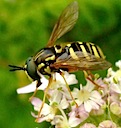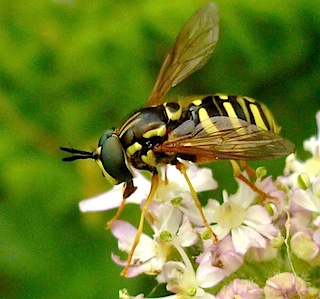 The striking and nationally scarce hoverfly Chrysotoxum elegans is often found near the coasts of south-west England and southern Wales. Poltesco is a good place to look for it.
The striking and nationally scarce hoverfly Chrysotoxum elegans is often found near the coasts of south-west England and southern Wales. Poltesco is a good place to look for it.
Photo: Andy Pay
Scientific name: Chrysotoxum elegans
Common name: Most hoverflies do not have a common name. In America, hoverflies are known as flower flies.
Conservation status: Nationally Scarce
What to look for:
- Colouring: This hoverfly has the yellow and black banding of a wasp-mimic and long antennae compared to other hoverflies (this is a characteristic of the Chrysotoxum genus).
- Size: Wing length 9.5 to 12 mm.
- Where: Near the coast of South West England and South Wales, and inland on chalk downlands in East England.
- Similar species: Five species of Chrysotoxum are hard to distinguish from each other. The other four are C. arcuatum, C. cautum, C. octomaculatum and C. veralli).
 Although a fair number of hoverflies in Britain are black in colour, we generally associate this family (Syrphidae) of the true flies (Order: Diptera) with the yellow and black or amber hues of wasp and bee mimicry (known as Batesian mimicry). From spring to early autumn, hoverflies are a common sight collecting nectar and pollen from wildflowers in meadows, woodland and in our own gardens. As the family name suggests, they are experts at hovering, and can hold their head completely still on the wing while feeding. Adults generally live only for a number of days to a few weeks, and use that time to feed, mate and for the females to lay eggs.
Although a fair number of hoverflies in Britain are black in colour, we generally associate this family (Syrphidae) of the true flies (Order: Diptera) with the yellow and black or amber hues of wasp and bee mimicry (known as Batesian mimicry). From spring to early autumn, hoverflies are a common sight collecting nectar and pollen from wildflowers in meadows, woodland and in our own gardens. As the family name suggests, they are experts at hovering, and can hold their head completely still on the wing while feeding. Adults generally live only for a number of days to a few weeks, and use that time to feed, mate and for the females to lay eggs.
The striking Chrysotoxum elegans (most hoverflies don’t have a common name) is a wasp-mimic, most often found near the coast in south-western England and southern Wales, but also on chalk downlands further east. It is nationally scarce. We don’t actually know much about the behaviour of its larvae, but species in this genus are thought to be associated with ants’ nests, in which the hoverfly larvae possibly feed on the root aphids being farmed by the ants for their honeydew.
Did you know…?
…Hoverflies can reach speeds of 40 km per hour – but only in short bursts.
…Although some species of hoverfly are hard to distinguish from each other, it’s relatively easy to tell the difference between males and females. The female’s eyes are separated from each other, whereas the male’s eyes meet at the top of its head.
More information and references:
Ball, S. and Morris, R., 2013. Britain’s Hoverflies: an Introduction to the Hoverflies of Britain. Princeton University Press, Woodstock, Oxfordshire.
Published: June 2015
Author: Amanda Scott
Photos: Andy Pay
